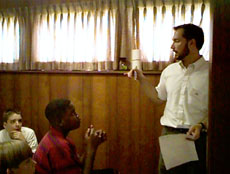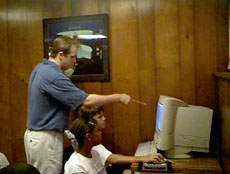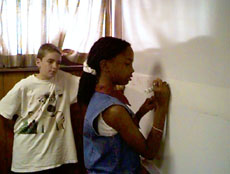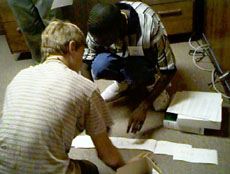|
July 14, 1997 The final session of the Internet Explorers Club began at 1:30 this afternoon, with students entering the Foundation's doors for the final session of the program. Still, neither the expectations nor the goals were any different than the previous sessions, and students would still be required to learn about the importance the Internet plays in the roles of the sciences. Indeed, the importance of science to the IEC program was the first thing that Joe South hit on at the beginning of today's session. Joe South, the program's principle instructor, brought to the students' attention that the Internet is an incredible tool for the distribution of scientific knowledge. Dr. Panoff, known to the students as Bob1, elaborated on this concept by explaining that the IEC student's would, by the end of the week, be able to ascertain the difference between 'noise' and 'fact.' Indeed, Dr. Panoff prescribed to the students a slew of words that they would need to understand in order to grasp an adequate understanding of the Internet: noise, signal, information, data, knowledge, and truth. Then, following this introduction to the IEC program, the students were introduced to the Shodor staff. Among the Shodor staff are two temporary interns from the Durham Public Schools' Youth Looking at the Future Today program. Justin and Ellie, the two students interning with the Foundation, are to spend their time working with the SUCCEED project and specifically this Eye E. See Observer. The goal is that they learn more about working in a real job. Next, following this introduction, the students were asked to learn more about one another. To do this, the students devised an investigative game in which they were able to ascertain knowledge about one another through a process similar to the ones scientists use to discover facts. By asking intuitive questions, the students were able to determine the facts about one another's true nature from a series of skillfully-directed questions. To complete their introductions to one another, Joe South worked through the scientific process, specifically citing the importance of observations to the six-step process:
Then, the student's were given their Post Office Protocol accounts and asked to complete their e-mail settings. Worked through the process by intern Andy Hebrank, the students successfully entered the world of computer communications. "There are a couple of rules most people should and do follow," explained Andy, referring to the proper usage of the Internet. Andy, again elaborating on proper email use explained to the students "that you should use common sense [on the Internet]." The students seemed to catch on quickly, understanding both the importance and risks of this communication tool. Once the students had spent some time e-mailing one another (and following a brief humorous dialogue by Quincy, one of the IEC students), it was time to work out an understanding of how the Internet functions. Joe South explained the origins of the Internet, from its original use as a means for counterstrike in Nuclear war to its birth as an educational tool among scientists. (The importance of peer review, necessitated the need for the use of the Internet by scientists.) The way in which material is transferred over the Internet was also of tantamount importance to the young Explorers. Redundancy, the repetition of various communications channels, makes the Internet a reliable way of transferring information. The repetitions across the globe appear to look like a web, hence the name "World Wide Web." To get a better understanding of this process the students were asked to complete an exercise in which they functioned like the Internet itself, moving a text along various 'routes' until it reaches its final destination and is reassembled. The message, "Tell Matt that there child swallowed a crayon and is bleeding ink," was properly reassembled, proving that the process works. The rest of the day was completed working on interactive web sites selected by the Foundation as appropriate and educational tools. These included an aircraft design site, a pH testing site, and a personality evaluation site, all of which proved to be of great interest to the students. Completing their first day with the foundation, the students seem eager to continue their journey into the world of computer information and the World Wide Web in particular. With a proper understanding of how the Internet works fresh on their minds, the students are ready to face the knew challenges of computer modeling, collaborative tools, and reasoning exercises that face them in the upcoming days ahead.
Last Update: June 14, 1999 Please direct questions and comments about this page to WebMaster@shodor.org © Copyright 1998 The Shodor Education Foundation, Inc. |





